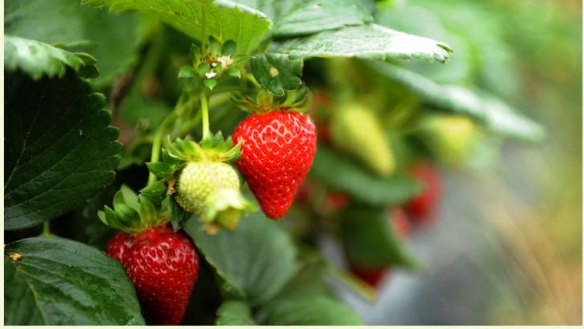God's fruit perfection

As summer approaches, there are few things better than picking fruits, berries and vegetables from your own garden, which are so much better harvested at their prime than the water-filled ones often sold in supermarkets.
Strawberries are one of the few crops that just about anyone can grow. I just love the quote from the 16th century English gourmand William Butler (reprinted in a Canberra Organic Growers Society article): "Doubtless God could have made a better berry but doubtless God never did."
Strawberries are by far the biggest berry crop grown across Australia, but home production has many benefits.
On a balcony you can grow one or two plants in a small pot. You can have them growing in a hanging basket or even in a vertical wall garden and they are excellent border plants to grow beside your kitchen herb garden.
Strawberries love rich soil with plenty of compost. The plants will thrive in a soil that has large clusters of soil particles and lots of humus to allow water and nutrients to penetrate and the soil microbes and earthworms to do their job. At this time of year, spread some pelletised organic fertiliser around each plant, water with a seaweed spray every two weeks and mulch well.
Strawberries enjoy warm summers and welcome protection from hot, drying winds. They don't like their roots to dry out (although they need well-drained soil).
Rain is very beneficial to strawberries; the nitrogen brought by a major downpour will trigger a wonderful flush of new flowers. If you are growing in containers, try to place them out where the rain is falling. A nightly inspection with a torch after rain will allow you to control slugs and slaters naturally, by simply picking them off and squashing them.
Well-maintained, healthy plants can produce between 300 and 500 grams of strawberries a season.
The plants peak in the second season after planting. In the third season, the roots become woody and productivity declines. To maintain yields and to keep diseases at bay, set yourself a goal of replanting every two seasons, in new ground every time.
The plants will begin to send out runners mid-season. It is best to limit the amount of energy the plant is putting into propagating itself this way if you want to encourage more flowers for this season. If you wish to set up runners for next winter's plantings, then allow one or two runners to proceed and layer in the stem below the leaf shoots that the runner has put out. Remove all other runners back at the main plant.
Among old favourite varieties are red gauntlet and Cambridge vigour. The Toolangi Strawberry Runner Growers Cooperative in Victoria has been searching worldwide for varieties that will produce quality fruit over an extended season. I sourced Albion from the co-operative and it is now regarded as the standout for growers in the southern states, producing a large, superior-tasting fruit over an extended period. It can handle extended wet periods better than many other varieties. San Andrea and portola are newer varieties of excellent quality that have also been brought in from the University of California breeding program.
This week
■ Sow beans, little finger carrots, cucumbers, summer lettuces, basil and coriander.
■ Finish setting up thin bamboo or wire-mesh growing frames for climbing beans and cucumbers. Secure these climbing plants with twine to the frames to provide stability.
■ Plant out remaining tomato, capsicum and eggplant seedlings.
■ Where you have space, prepare mounds with lots of compost materials and plant pumpkins, with three seeds for each 1-metre-round mound.
■ When planting out tomatoes, hammer in a solid 1.8-metre wooden stake beside each plant and tie up. Continue to secure it to the stake each 40cm as the plant grows taller. Pinch out the little laterals that are beginning to appear at the base of the branches.
■ Inspect the little new-season apples for signs of codling moth - look for the little borer's hole and "sawdust". Remove and destroy any apples with the holes to prevent a second generation from breeding.
>> Owen Pidgeon runs the Loriendale Organic Orchard near Hall.
Restaurant reviews, news and the hottest openings served to your inbox.
Sign up